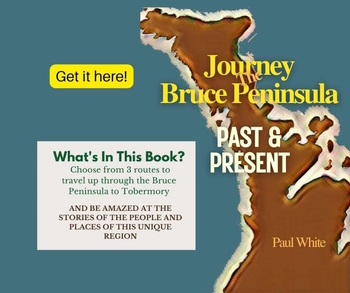An Unlikely Hero (Part 2) Meets the KKK
An Unlikely Hero Vs. The KKK: Our hero from Grey County took his missionary zeal south of the border and ultimately crossed paths with the infamous KKK!
Last week, I introduced you to an unlikely hero, the Reverend William Luke of Markdale and Flesherton. This week, we continue his story.
In order to continue his work with former slaves, Luke's only option was to travel to the southern part of the United States.
In July 1869, he arrived at the American Missionary Association offices in Cincinnati, Ohio. There he met Rev. Henry E. Brown, president of Talladega College, a school for freedmen in Alabama.
Luke began working with Brown and, within a short time, had received accolades for his hard work, devotion from his colleagues and the respect and trust of the black community.
He had left his family behind in Markdale and he worked hard to save money to send for them to join him in the south.
Then, an opportunity arose which would indeed provide him with the means to bring his family to him. The Selma, Rome and Dalton Railway, which was financed by the wealthy Astor family of New York, hired Luke to develop a model community for the freed slaves where they could have their own churches, schools and jobs with salaries equivalent to white workers.
What a stroke of luck for the hard-working Canadian striving to bring his family to him. Perhaps naively, Luke failed to realize that such a golden opportunity was also fraught with danger.
Although the North had defeated the South in the recent civil war, and the slaves had been freed, the local white community was not particularly open to the concept of free blacks, let alone former slaves earning a wage that was equivalent to theirs.
Luke, in particular, was a villain in the eyes of the local white community. When it was learned what he was doing in the black community, he was kicked out of his hotel room.
He took up residence with a black family. This further increased hostilities with some of the white citizens. Members of the Ku Klux Klan confronted Luke in Jacksonville, Ala. They threatened to kill him if he did not stop being a "nigger teacher." Within a week of the threats, shots were fired into his room. Fortunately, Luke was out of town at the time.
A short while later, an uprising occurred between some black men and a group of whites. In the ensuing battle, the blacks were arrested, and a mob went to Luke's home and arrested him. In what was, at best, a kangaroo court held the same evening, Luke was asked questions such as, "Did God view black women the same as white women?"
Answering these questions truthfully, Luke was thrown into jail with six black men to await sentencing. It came swiftly, but not in a court of law.
During the next few hours, the fields and roadways saw dozens of white-sheeted riders heading towards the jailhouse. The Klansmen gathered outside the jail. Then they went in and took Luke and his black companions. They were found the next morning. Some of the black men had been shot.
William Luke, the former minister from southern Grey County, had been hanged!
Luke's wife twice attempted to sue the local government in Alabama, but each time, her efforts were rebuffed.
William Luke, raised in Flesherton, schooled in Owen Sound, and who lived in Markdale for much of his life — hanged by the Ku Klux Kan July 11, 1870 in Alabama — has become something of a folk hero in that southern state.
His story has passed from one generation to the next at Talladega College and Piedmont, Alabama. The Alabama Public Television Network produced a film about William Luke. It was released in May 1996 under the title, The Wayfaring Stranger. It is based on the book written by Gene Howard, Death at Cross Plains. The book is available from University of Alabama Press at a cost of $16.95.
Note: Thanks again to Gene Howard of Jacksonville, Ala. for making his research notes available to me for this column.
A version of this article originally appeared in my Local History column in the Owen Sound Sun Times on June 29, 1996.
More Grey County Pages
12-year-old Walks to Owen Sound in 1851 from the journal of a teenage boy's experience travelling with his brother in the untamed Upper Canadian wilderness.
1st Grey County Building in 1852 was only built after many hurdles were overcame.
Dr. Anna Henry from Markdale, was a medical trailblazer for women doctors in Canada, who helped lay the groundwork for the establishment for Women's College Hospital.
Egremont Township endured the usual growing pains of a pioneer community, but its early history records times when it was embroiled in a few contentious issues.
Euphrasia Township in the early years when spelling the name was a problem for those who called it home and those that wanted settle this new Grey County township.
Georgian Bay's 1st pioneer settler arrived on the western shoreline long before any other settler reached the area.
Grey County Heritage: A Valuable Resource which is rich and varied, as an important resource for future use for business, political, and many other purposes.
Grey County's Creation in 1852, laid the framework for organizing a county in the last wilderness in the southern region of what would become in the future the province of Ontario.
An Unlikely Hero From Grey County (Part 1) found his way from the farming community of Flesherton to missionary work in the Ottawa Valley, and beyond.
An Unlikely Hero Vs. The KKK (Part 2) Our hero from Grey County took his missionary zeal south of the border and ultimately crossed paths with the infamous KKK!
Barn Raising: A Pioneer Economic and Social Necessity as it provided settlers with an opportunity not only to build a barn, but also build a community.
"Barring Out": A Pioneer School Tradition was a custom which the settlers brought to the new world from England, or Scotland.
Ceylon Ontario: How it Got its Name: It is always interesting how a community got its name, but I doubt any place received its name from a more unique source!
Chatsworth Ontario: First Settlers took advantage of fulfilling the needs of pioneer travellers and built a thriving community in the Upper Canadian wilderness.
Clearing Trees a Daunting Task for Settlers as they worked to fulfill their obligations for their land grant.
Dornoch: or is it Smithville? Originally it was Smithville, then it became Dornoch. But, surprise it is still, in reality Smithville!
First Pioneer in Durham: Archibald Hunter established his family, and a hotel, in what would become the centre of the town of Durham.
Durham Ontario Influenced by the Saugeen River. This river provided a means to create new industries, but especially in the spring it can also pose a menace to the community.
Grey County Bylaws to the 1890s reveal a lot about the financing of local government, especially education in the early days of the region.
John Muir, the legendary naturalist, who promoted the idea of protected nature spaces, spent time in Ontario and I went to help find evidence of his stay in the Owen Sound area.
A Heroic Woman From Grey County who made great changes as a doctor in China in the 1890s and early 1900s.
Jesse James: In Grey County? An interesting question. Did the notorious gangster hide out in Proton Township? We will never know. But it is fun to speculate!
Kilsyth's Train Engine was one for the history books. It brought an evening of joy followed by disappointing news soon after.
The Knight's of Meaford have long history in that Grey County community. Their business forged by early settlers employed many locals and supported the economy.
Leith: Tom Thomson's Birthplace is part of the rich heritage of this community located on the east shore of the Georgian Bay north of Owen Sound.
The Leith Golf Course has provided many families with great memories. The history of this golf course starts, and ends, with the generosity of one family.
Agnes Macphail was a political trailblazer in a part of Ontario that one could hardly expect such radical action for the era in a rural region.
Markdale Ontario: The Beginning: originally known as Glenelg East, but the coming of the railway and the name of owner of the land for the station led to a change of identity.
Meaford's history is one of hardy and entrepreneurial pioneers carving their lives out of the wilderness of what would become Grey County.
Meaford Ontario, first called Peggy's Landing located on the shores of Georgian Bay has a rich history.
Meaford vs Purdytown. Conflict over the name of a new community was not unusual in early Grey County but electing a school trustee was the "hot button" issue in this rivalry.
Pioneer Clergyman: John Neelands was the first to minister to the first settlers' spiritual needs riding on horseback through the wilds of early Grey County.
Pioneer Doctor: Dr. James Smith, a local boy who became a doctor and served his community for his entire life was a testament to Grey County community spirit.
Pioneer Healthcare in Grey and Bruce counties was not administered by doctors, nurses, or pharmacists, no it was the responsibility of the women of the community.
Pioneer Homes in Grey County in the 1840s offered only basic amenities. Homes were basic because clearing the land to earn a living to survive were of paramount importance for those embarking on a new life.
Pioneer Ingenuity created many labour saving devices and methods and quite often helped to create a sense of community.
Pioneer Christmas: A Family Tradition as told to me by may grandparents who experienced Christmas as children in the 1880s and 1890s.
Pioneer Settlement Plans for Grey County began almost two decades before the rest of Grey County was available for settlement.
A pioneer road surveyor's impact on the local history of Grey and Bruce counties could have been dramatic, if it had not been changed by another surveyor.
Pioneer Teachers in Grey and Bruce Counties had a long and arduous task, not to mentions strict and confining job requirements for very little salary.
Plowing Match in Grey County in 1933 the first International Plowing Match held in Grey and Bruce counties and it's success led to more such events in Grey.
Settling Osprey Township: Parts of Osprey were considered too rugged to settle, but today they are prime real estate because of the great view!
Swamp College: Proton Township: this colourfully named institution of education in Grey County has provided many stories to the heritage of the region.
Sydenham Township's First Council undertook the often difficult task of creating a new municipal infrastructure.
The Impact of Snow is not what is Used to be! As snow removal equipment has improved the impact of snow on our lives has reduced significantly from previous eras.
Unique Characters: Nathaniel Herriman lived in Grey County and owned an inn to provide food and and accommodation to early travellers. Each day he performed a unique practice.
Unique Maps: Quilts Guided the Underground Railroad to enable runaway slaves to escape to Canada and freedom from the shackles that enslaved them.
The Women's Institute is a group of rural women that has made a difference to the quality of both urban and rural life in Grey County and across the country.





